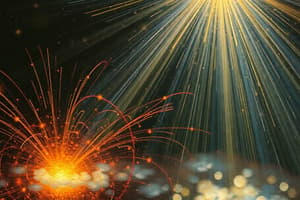Podcast
Questions and Answers
What is the fundamental process in the interaction between light and matter?
What is the fundamental process in the interaction between light and matter?
- Reflection
- Refraction
- Diffraction
- Photoelectric Effect (correct)
Who first observed the photoelectric effect in 1887?
Who first observed the photoelectric effect in 1887?
- Planck
- Thomas Edison
- Albert Einstein
- Heinrich Hertz (correct)
What is the basis of solar cells and other applications?
What is the basis of solar cells and other applications?
- Conduction of electricity
- Thermal expansion
- Reflection of light
- Photoelectric Current (correct)
According to Einstein's theory, what is directly proportional to the frequency of a photon?
According to Einstein's theory, what is directly proportional to the frequency of a photon?
What is the equation representing the energy of a photon according to Einstein's theory?
What is the equation representing the energy of a photon according to Einstein's theory?
What property of light is required for it to interact with a material and eject electrons?
What property of light is required for it to interact with a material and eject electrons?
What does the work function represent in the photoelectric effect?
What does the work function represent in the photoelectric effect?
Which equation proposed by Einstein describes the relationship between photon energy and frequency?
Which equation proposed by Einstein describes the relationship between photon energy and frequency?
In the context of the photoelectric effect, what does the maximum kinetic energy of ejected electrons depend on?
In the context of the photoelectric effect, what does the maximum kinetic energy of ejected electrons depend on?
What happens when photons with energy below the work function interact with material in the photoelectric effect?
What happens when photons with energy below the work function interact with material in the photoelectric effect?
How has the photoelectric effect impacted technology development?
How has the photoelectric effect impacted technology development?
What aspect of light determines the energy it can transfer to electrons in the photoelectric effect?
What aspect of light determines the energy it can transfer to electrons in the photoelectric effect?
Flashcards are hidden until you start studying
Study Notes
Photoelectric Effect and Its Components
The photoelectric effect, a fundamental process in the interaction between light and matter, has shaped our understanding of the nature of light and electrons. This phenomenon, first observed by Heinrich Hertz in 1887, was later explained by Albert Einstein in 1905 with his introduction of the photon concept.
Photoelectric Current
When light shines on a metal surface, electrons can be ejected, resulting in a flow of electric current. This phenomenon, known as the photoelectric current, is the basis of solar cells and other applications.
The photoelectric current is not simply the result of an increase in temperature, as claimed by classical theories at the time. Instead, it requires light of a specific frequency (or energy) to interact with the material, and the number of ejected electrons is proportional to the intensity of light.
Einstein's Photoelectric Effect Equation
Einstein explained the photoelectric effect in terms of quantized energy packets called photons. According to his theory, the energy of each photon is directly proportional to its frequency, (E=h\nu), where (E) is the photon's energy, (h) is Planck's constant (approximately (6.626\times 10^{-34}) J s), and (\nu) is the photon's frequency.
To understand the photoelectric effect, Einstein proposed the following equation for the maximum kinetic energy of the ejected electrons, (K_{\text{max}}):
[K_{\text{max}}=h\nu-W_0]
In this equation, (W_0) is the work function, which is the minimum energy required to remove an electron from the surface of the material.
Photon Energy
The photoelectric effect demonstrates that light, composed of photons, has energy that can be transferred to electrons. The energy of a photon is directly proportional to its frequency, as described by Einstein's equation, (E=h\nu).
In other words, photons can have different energies depending on their frequency. When light interacts with a material, the electrons can absorb photons with energy greater than their binding energy, or work function, and be ejected.
The photoelectric effect has not only revolutionized our understanding of light and matter but also led to the development of various applications like solar cells and photodetectors. With these insights, we continue to explore the fascinating world of photonics and quantum physics.
Studying That Suits You
Use AI to generate personalized quizzes and flashcards to suit your learning preferences.




